Answered step by step
Verified Expert Solution
Question
1 Approved Answer
The intrinsic viscosity and molar mass were determined by light scattering. natural on 5 fractions considered isomolecular of polystyrene in solution in butanone. The measurements
The intrinsic viscosity and molar mass were determined by light scattering. natural on fractions considered isomolecular of polystyrene in solution in butanone. The measurements are carried out at
we give the values of also the value of P of the slope at the origin of the angular dependence of which has the expression SEE TABLE ON PICTURE
Calculate the molar masses of the fractions.
Calculate the radius of gyration of the molecules.
Calculate the coefficients K and a of the MarkHouvink equation for PS in butanone.
Calculate the radii of gyration of molecules using the FloryFox relation.
Compare with those obtained by light scattering. What is the law of variation of the radius of gyration with the molar mass?

Step by Step Solution
There are 3 Steps involved in it
Step: 1

Get Instant Access to Expert-Tailored Solutions
See step-by-step solutions with expert insights and AI powered tools for academic success
Step: 2

Step: 3

Ace Your Homework with AI
Get the answers you need in no time with our AI-driven, step-by-step assistance
Get Started


